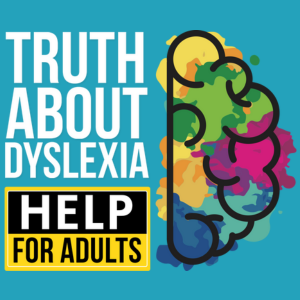
How The Dyslexic Brain Works - With Andrée Kelly
Share
Have you ever wondered how a dyslexic brain really works? This episode goes deep into why adults with dyslexia process information in creative and different ways. It also looks at how ADHD and dyslexia often overlap and what that means for day-to-day life.
In this chat, Stephen Martin and Andre Kelly break down new research comparing neurotypical and dyslexic brains. They also talk about how people with dyslexia can see what others miss and how that can be both a blessing and a challenge. If you ever felt like you notice details no one else does, or you’re juggling ADHD-like traits alongside dyslexia, you’re not alone.
How a Dyslexic Brain Really Works
Dyslexic individuals often process information in the back part of the brain. That can mean a unique way of seeing ideas and details. While some might see this as a drawback, it can be your hidden superpower.
You might find that you pick up on patterns or ideas in a snap, while others need more time. As Andre explains, though, this sensitivity to extra input can feel overwhelming in a world geared towards neurotypical minds.
“Our minds simply process the world differently, and that can give us a fresh perspective.”
The Crossover with ADHD
If you’ve noticed signs of ADHD alongside dyslexia, you’re not imagining it. Stephen and Andre discuss how many dyslexic adults also share traits like restlessness or difficulty focusing for long periods.
This overlap might seem confusing at first, but it can also help you understand your own strengths. If your mind darts between ideas, it might be that you’re wired to see patterns that others miss.
Seeing the Bigger Picture
One amazing aspect of dyslexia is the ability to see the world in wide-screen. This big-picture thinking is perfect for brainstorming solutions or spotting details others ignore.
It’s as if you have a built-in zoom lens. You can observe an entire landscape of ideas, then switch to something smaller and laser-focused without warning. That’s why many dyslexic adults succeed in creative fields or problem-solving roles.
Finding Support in a Busy World
It’s not easy to thrive when everything around you is designed for neurotypical ways of learning and working. Simple tasks can become stressful. Accessing help might mean digging to find a support group or special resource.
- Look for mentors who understand neurodiversity.
- Experiment with apps or tools that help you organise your thoughts.
- Focus on environments that allow for flexible, out-of-the-box thinking.
Even if it feels like no one quite gets it, there are people out there who do. With proper understanding, you can tap into your dyslexic strengths instead of feeling held back.
What This Means for You
Living with dyslexia—and sometimes ADHD—can feel lonely. But you aren’t alone. By finding the right support and resources, you can make sense of all that extra information your brain absorbs.
If you’re juggling both conditions, it might help to see them not as two separate labels but as two sides of a unique coin. Once you recognise patterns in how you think, everyday life often gets easier.
- The dyslexic brain works differently, emphasising back-of-the-brain processing.
- Dyslexic individuals can spot the bigger picture and hidden details.
- There’s a strong link between dyslexia and ADHD traits.
- Community and understanding can make a world of difference.
Ready to explore more? Listen to the full episode at the top of the page to hear the full conversation. You can also dive deeper into adult dyslexia resources at truthaboutdyslexia.com and join our supportive Facebook Group at facebook.com/groups/adultdyslexia.

